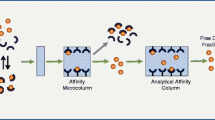Abstract
In order to ensure the stability of protein pharmaceuticals, human serum albumin (HSA) is often added as an excipient, frequently in large excess. This makes chromatographic analysis of the stability of the active protein difficult. In the case of interleukin-4 (IL-4), separation from HSA can be achieved to some degree by size exclusion chromatography, but some HSA co-elutes with the IL-4. Hydrophobic ion pairing provides a method for selective precipitation of IL-4 from HSA. Hydrophobic ion pairing involves the electrostatic interaction of ionic detergents with oppositely charged polypeptides. Even when HSA is present in fifty-fold excess (w/w), the resulting precipitate contains greater than 70% of the IL-4. Selective precipitation with SDS produces enhancements in IL-4 over HSA of more than 2000-fold. This approach permits subsequent facile analysis of IL-4 by conventional reverse phase HPLC.
Similar content being viewed by others
REFERENCES
F. W. Putnam and H. Neurath. The precipitation of proteins by synthetic detergents. J. Am. Chem. Soc. 66:692–698 (1944).
J. Oakes and M. C. Cafe. Magnetic resonance studies of the interactions between bovine serum albumin and surfactants. Eur. J. Biochem. 36:559–563 (1973).
J. E. Moskaitis and A. T. Campagnoni. A comparison of the dodecyl sulfate-induced precipitation of the myelin basic protein with other water-soluble proteins. Neurochem. Res. 11:299–315 (1986).
P.-O. Hegg. Precipitation of egg white proteins below their isoelectric points by sodium dodecyl sulphate and temperature. Biochim. Biophys. Acta 579:73–87 (1979).
I. A. Braude and E. De Clerq. Mechanism of interaction of sodium dodecyl sulfate with mouse interferon. J. Biol. Chem. 254:7758–7764 (1979).
J. Matsuura, M. E. Powers, M. C. Manning, and E. Shefter. Structure and stability of insulin dissolved in 1-Octanol. J. Am. Chem. Soc. 115:1261–1264 (1993).
M. E. Powers, J. Matsuura, J. Brassell, M. C. Manning, and E. Shefter. Enhanced solubility of proteins and peptides in nonpolar solvents through hydrophobic ion pairing. Biopolymers 33:927–932 (1993).
Author information
Authors and Affiliations
Rights and permissions
About this article
Cite this article
Meyer, J.D., Matsuura, J.E., Ruth, J.A. et al. Selective Precipitation of Interleukin-4 Using Hydrophobic Ion Pairing: A Method for Improved Analysis of Proteins Formulated with Large Excesses of Human Serum Albumin. Pharm Res 11, 1492–1495 (1994). https://doi.org/10.1023/A:1018916627891
Issue Date:
DOI: https://doi.org/10.1023/A:1018916627891




